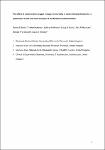The effect of conservative oxygen therapy on mortality in adult critically ill patients: A systematic review and meta-analysis of randomised controlled trials
| dc.contributor.author | Martin, DS | |
| dc.contributor.author | Mckenna, HT | |
| dc.contributor.author | Rowan, KM | |
| dc.contributor.author | Gould, DW | |
| dc.contributor.author | Mouncey, PR | |
| dc.contributor.author | Grocott, MPW | |
| dc.contributor.author | Harrison, DA | |
| dc.date.accessioned | 2023-11-13T10:03:05Z | |
| dc.date.available | 2023-11-13T10:03:05Z | |
| dc.date.issued | 2023-11 | |
| dc.identifier.issn | 1751-1437 | |
| dc.identifier.issn | 2057-360X | |
| dc.identifier.uri | https://pearl.plymouth.ac.uk/handle/10026.1/21634 | |
| dc.description.abstract |
<jats:sec><jats:title>Background:</jats:title><jats:p> Oxygen is the commonest intervention provided to critically ill patients requiring mechanical ventilation. Despite this, it is unclear how much oxygen should be administered to patients in order to promote the best clinical outcomes and it has been suggested that a strategy of conservative oxygen therapy (COT) may be advantageous. We therefore sought to answer the question of whether COT versus usual or liberal oxygen therapy was beneficial to adult patients receiving mechanical ventilation on an intensive care unit (ICU) by performing a systematic review and meta-analysis. </jats:p></jats:sec><jats:sec><jats:title>Methods:</jats:title><jats:p> Studies were included if they were randomised controlled trials comparing COT to liberal or usual oxygen therapy strategies in acutely ill adults (aged ⩾18 years) admitted to an ICU, and reported an outcome of interest. Studies were excluded if they were limited to a specific single disease diagnosis. The review was registered on PROSPERO (CRD42022308436). Risk of bias was assessed using a modified Cochrane Risk of Bias assessment tool. Effect estimates were pooled using a random effects model with the between study variance estimated using restricted maximum likelihood and standard errors calculated using the method of Hartung-Knapp/Sidik-Jonkman. Between study heterogeneity was quantified using the I<jats:sup>2</jats:sup> statistic. The certainty in the body of evidence was assessed using GRADE criteria. </jats:p></jats:sec><jats:sec><jats:title>Results:</jats:title><jats:p> Nine eligible studies with 5727 participants fulfilled all eligibility criteria. Trials varied in their definitions of COT and liberal or usual oxygen therapy. The pooled estimate of risk ratio for 90 day mortality for COT versus comparator was 0.99 (95% confidence interval 0.88–1.12, 95% prediction interval 0.82–1.21). There was low heterogeneity among studies ( I<jats:sup>2</jats:sup> = 22.4%). The finding that mortality was similar for patients managed with COT or usual/liberal oxygen therapy was graded as moderate certainty. </jats:p></jats:sec><jats:sec><jats:title>Conclusions:</jats:title><jats:p> In critically ill adults admitted to an ICU, COT is neither beneficial nor harmful when compared to usual or liberal oxygen therapy. Trials to date have been inconsistent in defining both COT and liberal or usual oxygen therapy, which may have had an impact on the results of this meta-analysis. Future research should focus on unifying definitions and outcome measures. </jats:p></jats:sec> | |
| dc.format.extent | 399-408 | |
| dc.format.medium | Print-Electronic | |
| dc.language | en | |
| dc.publisher | SAGE Publications | |
| dc.subject | Oxygen | |
| dc.subject | critical illness | |
| dc.subject | systematic review | |
| dc.subject | meta-analysis | |
| dc.title | The effect of conservative oxygen therapy on mortality in adult critically ill patients: A systematic review and meta-analysis of randomised controlled trials | |
| dc.type | journal-article | |
| dc.type | Review | |
| plymouth.author-url | https://www.ncbi.nlm.nih.gov/pubmed/37841302 | |
| plymouth.issue | 4 | |
| plymouth.volume | 24 | |
| plymouth.publisher-url | http://dx.doi.org/10.1177/17511437231192385 | |
| plymouth.publication-status | Published | |
| plymouth.journal | Journal of the Intensive Care Society | |
| dc.identifier.doi | 10.1177/17511437231192385 | |
| plymouth.organisational-group | |Plymouth | |
| plymouth.organisational-group | |Plymouth|Faculty of Health | |
| plymouth.organisational-group | |Plymouth|REF 2021 Researchers by UoA | |
| plymouth.organisational-group | |Plymouth|Users by role | |
| plymouth.organisational-group | |Plymouth|Users by role|Academics | |
| plymouth.organisational-group | |Plymouth|REF 2021 Researchers by UoA|UoA01 Clinical Medicine | |
| plymouth.organisational-group | |Plymouth|Faculty of Health|Peninsula Medical School | |
| plymouth.organisational-group | |Plymouth|REF 2028 Researchers by UoA | |
| plymouth.organisational-group | |Plymouth|REF 2028 Researchers by UoA|UoA01 Clinical Medicine | |
| dc.publisher.place | England | |
| dcterms.dateAccepted | 2023-07-04 | |
| dc.date.updated | 2023-11-13T10:02:47Z | |
| dc.rights.embargodate | 2023-11-14 | |
| dc.identifier.eissn | 2057-360X | |
| rioxxterms.versionofrecord | 10.1177/17511437231192385 |


